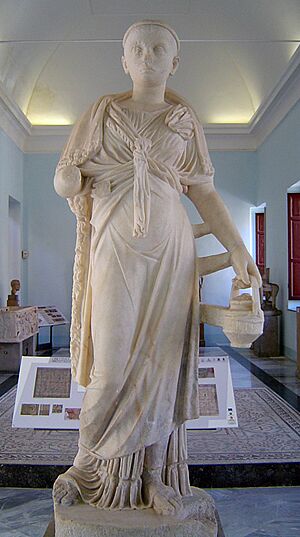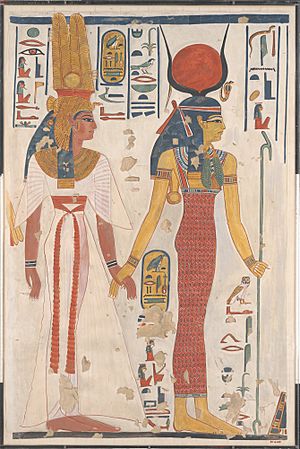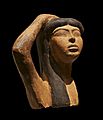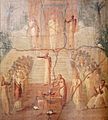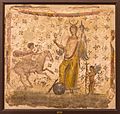Isis facts for kids
Quick facts for kids Isis |
|
|---|---|
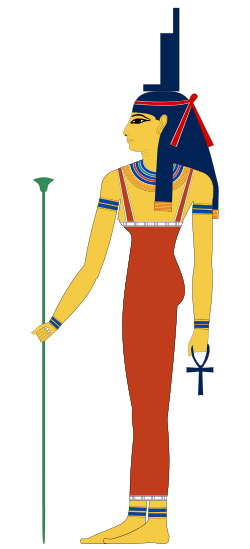 |
Isis (pronounced eye-sis) was a powerful goddess in ancient Egyptian mythology. She was the wife of Osiris and the mother of their son named Horus. Isis was known for protecting children and was considered one of the most important goddesses. She was also seen as the greatest magician and the goddess of magic.
Isis was very important in magical writings from the Middle Kingdom onwards. Stories often tell of the dangers Horus faced as a child. In many healing spells, Isis's efforts to heal Horus were used to help any sick person. Sometimes, Isis would even make the sun god Ra help Horus. She would threaten to stop the sun from moving across the sky if her son wasn't cured.
Later, in the fourth century BCE, Nectanebo I, a pharaoh, said Isis was his special protector. This made her even more connected to royal power. Cleopatra VII, the last ruler of Egypt before the Romans took over, even called herself "the new Isis."
During Roman times, Egyptians all over the country celebrated Isis's birthday. They would carry her statue through their fields. This probably celebrated her powers of making things grow. Priests at Philae held a festival every ten days. Isis's statue would visit the nearby island of Bigeh, where Osiris was said to be buried. There, priests would perform special ceremonies for him.
Contents
What Her Name Means
The name "Isis" that we use in English comes from the Greek name, Ίσις. The Greeks added an "-s" to the original Egyptian name. This was because of the rules for how Greek nouns end.
Her Family
Isis was part of a group of nine gods called the Ennead. These gods were all descended from the creator god, Atum or Ra. Isis and her siblings—Osiris, Set, and Nephthys—were the last generation of this family. Their parents were Geb, the god of the earth, and Nut, the goddess of the sky.
The creator god, who was the first ruler of the world, passed his power down through the male gods of the Ennead. This is how Osiris became king. Isis, as Osiris's wife, was his queen.
Her Story
Isis was first mentioned in the Old Kingdom (around 2686–2181 BCE). She was a main character in the Osiris myth. In this story, she brings her dead brother and husband, the king Osiris, back to life. She also gives birth to and protects his son, Horus.
People believed Isis helped the dead enter the afterlife, just as she had helped Osiris. She was also seen as the divine mother of the pharaoh.
Later, around 1000 BCE, Osiris and Isis became the most worshipped Egyptian gods. Isis took on traits from many other goddesses. Rulers in Egypt and Nubia built temples mainly for Isis. Her temple at Philae was a religious center for both Egyptians and Nubians.
Isis was believed to have more magical power than all other gods. People said she protected Egypt from enemies. She also controlled the skies and nature, and even had power over fate.
During the Hellenistic period (323–30 BCE), when Greeks ruled Egypt, Isis was worshipped by both Greeks and Egyptians. She was worshipped alongside a new god, Serapis. Their worship spread across the wider Mediterranean world. Greek followers gave Isis traits from Greek deities. For example, they said she invented marriage and protected ships at sea.
Herodotus, a Greek writer, compared Isis to the Greek goddess Demeter. Demeter's search for her daughter Persephone was similar to Isis's search for Osiris. This link helped connect the two cultures.
As Roman culture grew, the worship of Isis became part of Roman religion. Her followers were a small part of the Roman Empire's population. But they were found everywhere. Her worship developed special festivals like the Navigium Isidis. It also had initiation ceremonies similar to other Greco-Roman mystery cults. Some followers even said she held all feminine divine powers in the world.
The worship of Isis ended with the rise of Christianity between the fourth and sixth centuries CE.
In Egyptian Myths
When Set kills Osiris, Isis and Nephthys, along with other gods, search for the pieces of his body. They put him back together. Their actions became the model for mummification and other ancient Egyptian funerary practices.
Isis is shown as a grieving widow. Her and Nephthys's love and sadness help bring Osiris back to life. Isis also uses magical spells to restore him. When Isis finally brings breath and life back to Osiris's body, she gives birth to their son, Horus. After this, Osiris lives only in the Duat, the underworld. But by having a son to get revenge and perform funeral rites, Isis made sure her husband would live on in the afterlife.
Isis gives birth to Horus and must protect him from Set and many dangers. These included snakes, scorpions, and illnesses. One story says seven minor scorpion gods traveled with her and guarded her. They stung a rich woman's son because she refused to help Isis. This made the goddess heal the innocent child. Isis's fame as a kind goddess, willing to help people, made her very popular.
Her Powers
Isis was a powerful magician and protector. A great example of her powers is when she brought Osiris back to life for one night. Her actions protecting Osiris against Set showed her strong, warlike side. Later Egyptian texts show Isis in the boat of Ra as he sails through the underworld. She helps other gods defeat Ra's main enemy, Apep.
Kings also asked for her protective magical power against human enemies. In her temple at Philae, near the border with Nubia, she was called the protector of the whole nation. She was said to be more effective in battle than "millions of soldiers." She supported kings and emperors in fighting Egypt's enemies.
Isis was "more clever than a million gods." She used her skills to outsmart Set during his fight with her son. Once, she changed into a young woman. She told Set she was in a dispute over inheritance, similar to Set taking Osiris's crown. When Set said this situation was unfair, Isis teased him. She said he had judged himself to be wrong. In later texts, she used her transformation powers to fight and destroy Set and his followers.
Another time, Isis created a snake that bit Ra, who was older and greater than she was. The venom made him sick. She offered to cure Ra if he would tell her his true, secret name. Knowing this name would give her amazing power. After much convincing, Ra told her his name. She then passed it on to Horus, making his royal authority stronger. This story might explain why Isis's magic was greater than other gods. But because she used magic to control Ra, it seems she had these powers even before knowing his name.
Isis's power over nature was believed to provide food for humans, the blessed dead, and the gods.
Her Roles
Isis's role in afterlife beliefs came from Osiris's myth. She helped bring the souls of dead humans back to wholeness, just as she had done for Osiris. Like other goddesses, such as Hathor, she also acted as a mother to the dead, giving them protection and nourishment.
Isis's most important job, though, was protecting Egypt and supporting its king. She was seen as the mother and wife of kings. Temple carvings show Isis nursing the king. This symbolized his divine right to rule. She was also one of the gods who protected and helped the king in the afterlife.
Isis was also linked with rain, which Egyptian texts called a "Nile in the sky." As the provider of rain, she brought life to the natural world.
In the Greek and Roman world, Isis was often connected with marriage and parenthood. People prayed to her to protect women during childbirth. She was often described as a cosmic goddess. People believed she controlled the sun, moon, and stars. She governed time and the seasons, which helped the earth stay fertile. These texts also said she invented farming, created laws, and helped develop other parts of human society.
Isis also watched over seas and harbors. Sailors left messages asking her to keep their voyages safe and lucky. In this role, she was called Isis Pelagia, meaning "Isis of the Sea." Or Isis Pharia, referring to a sail or the island of Pharos, where the Lighthouse of Alexandria stood. So, Isis made sure there were good harvests and protected the ships that carried food across the seas. This helped the entire empire stay healthy. Her protection of the state also extended to Rome's armies. She was sometimes called Isis Invicta, meaning "Unconquered Isis." Her roles were so many that she was called myrionymos, "one with countless names," and panthea, "all-goddess."
How She Looked
Isis often had a sun disk on her head. She appeared as a queen. Sometimes, Isis was called the egg of the goose because Geb was her father, and a goose represented him. She also wore a throne on her head to show she was a queen.
In ancient Egyptian art, Isis was usually shown as a woman. She had the typical look of a goddess: a long dress, a papyrus staff in one hand, and an ankh sign in the other. Her first headdress was the throne sign used to write her name. She and Nephthys often appeared together. This was especially true when they were mourning Osiris, supporting him on his throne, or protecting the coffins of the dead.
Isis sometimes appeared as animals. She could be a sow (female pig), showing her motherly side. She could also be a cow, especially when linked with Apis. Or she could be a scorpion. She also took the form of a tree or a woman coming out of a tree. Sometimes, she offered food and water to dead souls.
Worship of Isis
Many Egyptian gods and goddesses started in one specific place. They often had their own city where they were worshipped. However, no local cities where Isis was worshipped have been found from her early history. There are no known temples built just for her until the 30th dynasty. Before that, Isis was worshipped in temples of other gods or goddesses. Even in the 30th dynasty, Isis was worshipped alongside Horus and Osiris.
Temples dedicated to Isis became common in Roman times. A famous temple was built for her at Philae. Its building started during the Thirtieth Dynasty and was finished or made bigger by Ptolemaic kings. Many other Isis temples appeared during Ptolemaic times. They ranged from Alexandria and Canopus on the Mediterranean coast to Egypt's border with Nubia.
In many places, her followers took over the worship of the Semitic goddess Astarte. This was because their names were similar. In the Greek era, because she was known as a protector and mother, she also became the goddess of sailors.
Temples to Isis were built in Iraq, Greece, Rome, and even as far north as England. Remains of a temple were found at Hadrian's Wall. At Philae, she was worshipped until the 6th century, even after Christianity became popular. The closing of her temples is often seen as the end of ancient Egypt.
Hundreds of thousands of amulets and small statues of Isis nursing Horus were made around 1000 BCE. In Roman Egypt, she was one of the most common gods shown in household religious art, like figurines and paintings.
Priests and Priestesses
We don't have much information about Egyptian priests of Isis. But we know that there were both male and female priests throughout her history. By the Greek and Roman times, many of them were healers. They were also said to have other powers, like explaining dreams and controlling the weather by braiding or combing their hair.
Her Influence Today
The memory of Isis lived on even after her worship ended. Like the Greeks and Romans, many modern Europeans have seen ancient Egypt as a place of deep and mystical wisdom. This wisdom has often been linked with Isis.
Among modern Egyptians, Isis was used as a national symbol in the 1920s and 1930s. This was when Egypt gained independence from British rule. In artworks like Mohamed Naghi's painting in the parliament of Egypt, called Egypt's Renaissance, Isis symbolizes the nation's rebirth. A sculpture by Mahmoud Mokhtar, also called Egypt's Renaissance, shows Isis removing her veil.
Isis appears often in fiction, like a superhero franchise. Her name and image are used in many different places, from advertisements to personal names. The name Isidoros, meaning "gift of Isis" in Greek, continued to be used in Christianity despite its pagan origins. This led to the English name Isidore and its variations. In recent times, "Isis" itself became a popular feminine given name.
Images for kids
-
Isis holds the king, Seti I, in her lap, thirteenth century BCE
-
Philae as seen from Bigeh Island, painted by David Roberts in 1838
-
The remains of the temple of Isis on Delos
-
The Temple of Isis in Pompeii
-
Fresco of an Isiac gathering, first century CE. One priest tends a fire while another holds up a vessel of sacred water at the door of a temple flanked by sphinxes.
-
Winged Isis at the foot of the sarcophagus of Ramesses III, twelfth century BCE
-
Bronze figurine of Isis-Fortuna with a cornucopia and a rudder, first century CE
See also
 In Spanish: Isis para niños
In Spanish: Isis para niños


